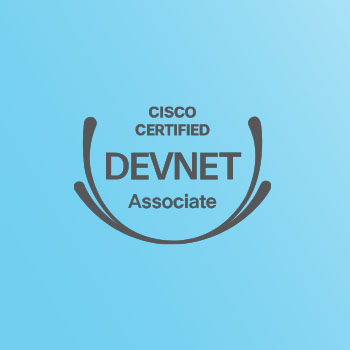الان اینجا هستید:

دوره CCNA DevNet Associate 200-901
- نوع دوره: حضوری و آنلاین
- تقویم برگزاری دوره
ناموجود
در حال حاضر کلاسی برای این دوره موجود نیست، اما شما میتوانید درخواست خود را برای برگزاری مجدد این دوره از فرم زیر برای ما ارسال کنید.
"(اجباری)" indicates required fields
- چرا کندو؟

ضبط تصویری

دسترسی ریموت

ضمانت شغل
- معرفی این دوره
Cisco DevNet برنامه توسعه دهنده سیسکو برای کمک به توسعه دهندگان و متخصصان فناوری اطلاعات است که میخواهند برنامه های کاربردی بنویسند و با دستگاه های سیسکو یکپارچه سازی کنند. Cisco DevNet Associate برای افرادی در نظر گرفته شده است که نقش توسعه دهنده را ایفا می کنند. این برنامه مهارتهای فنی متخصصان فناوری اطلاعات را تأیید میکند و به سازمانها اجازه میدهد تا از پتانسیل برنامهها، اتوماسیون و زیرساختهای شبکه، اینترنت اشیا، DevOps و Cloud استفاده کنند.
- مدرک پایان دوره
- کندو معتبرترین آموزشگاه IT ایران است که بیشترین فارغالتحصیلان را دارد.
- بسیاری از مدیران صنعت IT ایران در آموزشگاه کندو دوره دیدهاند.
- بسیاری از فارغ التحصیلان آموزشگاه کندو خارج از ایران مشغول به کار شدهاند.
- مدرک کندو قابلیت ترجمه و استفاده برای امور مهاجرتی را نیز دارد.
- مدارک دورههای حضوری و آنلاین هیچ تفاوتی با هم ندارند.
نمونه مدارک:
- اهداف و دستاوردها
- توسعه و طراحی نرم افزار را پوشش می دهد.
- درک و استفاده از API ها پلتفرم و توسعه سیسکو استقرار و امنیت برنامه
- امکانات و فضای آموزشگاه
- لابراتوار تجهیز شده ۲۴ ساعته و رایگان
- سیستم و اینترنت پرسرعت + فیلترشکن
- ضبط محتوای کلاس و دسترسی دائم به آن
- کافه + امکانات پذیرایی بین کلاس
- فوتبال دستی و پینگ پنگ
- فضای سبز تجهیز شده
دو آموزشگاه در تهران:
- ساختمان میرعماد: خیابان مطهری، خیابان میرعماد، کوچه جنتی ۱۳، پلاک ۳۰ (فاصله تا متروی بهشتی ۵ دقیقه پیاده)
- ساختمان سنایی: خیابان سنایی، تقاطع خیابان مطهری، کوچه ۲۱، پلاک ۲ (فاصله تا متروی میرزای شیرازی ۱۰ دقیقه پیاده و ایستگاه BRT ولیعصر ۱۰ دقیقه)
مسیریابی از روی گوگلمپ:
- سرفصل های CCNA DevNet Associate 200-901
- Software Development and Design
- Compare data formats (XML, JSON, and YAML)
- Describe parsing of common data format (XML, JSON, and YAML) to Python data
structures - Describe the concepts of test-driven development
- Compare software development methods (agile, lean, and waterfall)
- Explain the benefits of organizing code into methods / functions, classes, and modules
- Identify the advantages of common design patterns (MVC and Observer)
- Explain the advantages of version control
- Utilize common version control operations with Git
- Clone
- Add/remove
- Commit
- Push / pull
- Branch
- Merge and handling conflicts
- Diff
- Understanding and Using APIs
- Construct a REST API request to accomplish a task given API documentation
- Describe common usage patterns related to webhooks
- Identify the constraints when consuming APIs
- Explain common HTTP response codes associated with REST APIs
- Troubleshoot a problem given the HTTP response code, request and API documentation
- Identify the parts of an HTTP response (response code, headers, body)
- Utilize common API authentication mechanisms: basic, custom token, and API keys
- Compare common API styles (REST, RPC, synchronous, and asynchronous)
- Construct a Python script that calls a REST API using the requests library
- Cisco Platforms and Development
- Construct a Python script that uses a Cisco SDK given SDK documentation
- Describe the capabilities of Cisco network management platforms and APIs (Meraki,
Cisco DNA Center, ACI, Cisco SD-WAN, and NSO) - Describe the capabilities of Cisco compute management platforms and APIs (UCS
Manager, UCS Director, and Intersight) - Describe the capabilities of Cisco collaboration platforms and APIs (Webex Teams,
Webex devices, Cisco Unified Communication Manager including AXL and UDS
interfaces, and Finesse) - Describe the capabilities of Cisco security platforms and APIs (Firepower, Umbrella,
AMP, ISE, and ThreatGrid - Describe the device level APIs and dynamic interfaces for IOS XE and NX-OS
- Identify the appropriate DevNet resource for a given scenario (Sandbox, Code Exchange,
support, forums, Learning Labs, and API documentation) - Apply concepts of model driven programmability (YANG, RESTCONF, and NETCONF) in a
Cisco environment - Construct code to perform a specific operation based on a set of requirements and given
API reference documentation such as these:
- Obtain a list of network devices by using Meraki, Cisco DNA Center, ACI, Cisco
SD-WAN, or NSO - Manage spaces, participants, and messages in Webex Teams
- Obtain a list of clients / hosts seen on a network using Meraki or Cisco DNA
Center
- Application Deployment and Security
- Describe benefits of edge computing
- Identify attributes of different application deployment models (private cloud, public
cloud, hybrid cloud, and edge - Identify the attributes of these application deployment types
- Virtual machines
- Bare metal
- Containers
- Describe components for a CI/CD pipeline in application deployments
- Construct a Python unit test
- Interpret contents of a Dockerfile
- Utilize Docker images in local developer environment
- Identify application security issues related to secret protection, encryption (storage and
transport), and data handling - Explain how firewall, DNS, load balancers, and reverse proxy in application deployment
- Describe top OWASP threats (such as XSS, SQL injections, and CSRF)
- Utilize Bash commands (file management, directory navigation, and environmental
variables) - Identify the principles of DevOps practices
- Infrastructure and Automation
- Describe the value of model driven programmability for infrastructure automation
- Compare controller-level to device-level management
- Describe the use and roles of network simulation and test tools (such as VIRL and pyATS)
- Describe the components and benefits of CI/CD pipeline in infrastructure automation
- Describe principles of infrastructure as code
- Describe the capabilities of automation tools such as Ansible, Puppet, Chef, and Cisco
NSO - Identify the workflow being automated by a Python script that uses Cisco APIs including
ACI, Meraki, Cisco DNA Center, or RESTCONF - Identify the workflow being automated by an Ansible playbook (management packages,
user management related to services, basic service configuration, and start/stop) - Identify the workflow being automated by a bash script (such as file management, app
install, user management, directory navigation) - Interpret the results of a RESTCONF or NETCONF query
- Interpret basic YANG models
- Interpret a unified diff
- Describe the principles and benefits of a code review process
- Interpret sequence diagram that includes API calls
- Interpret sequence diagram that includes API calls
- Describe the purpose and usage of MAC addresses and VLANs
- Describe the purpose and usage of IP addresses, routes, subnet mask / prefix, and
gateways - Describe the function of common networking components (such as switches, routers,
firewalls, and load balancers) - Interpret a basic network topology diagram with elements such as switches, routers,
firewalls, load balancers, and port values - Describe the function of management, data, and control planes in a network device
- Describe the functionality of these IP Services: DHCP, DNS, NAT, SNMP, NTP
- Recognize common protocol port values (such as, SSH, Telnet, HTTP, HTTPS, and
NETCONF) - Identify cause of application connectivity issues (NAT problem, Transport Port blocked,
proxy, and VPN) - Explain the impacts of network constraints on applications
- داشجویان کندو مشغول به کار شدن در...

فناوری اطلاعات شاتل

شرکت عالیفرد سنایچ

بانک پاسارگاد

بانک ملت

شرکت ارتباطات آسیاتک

پیشگامان توسعه ارتباطات

ایران خودرو

بانک خاورمیانه

ماموت خودرو

پارس خودرو
- اساتید این دوره
- نظرات شما






